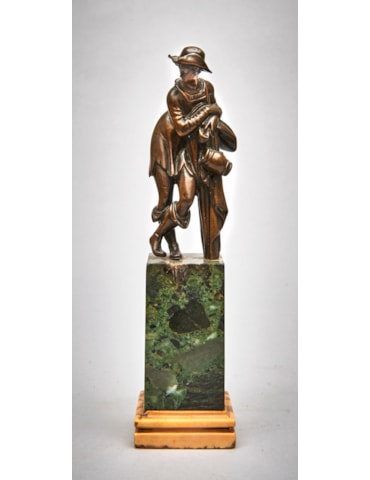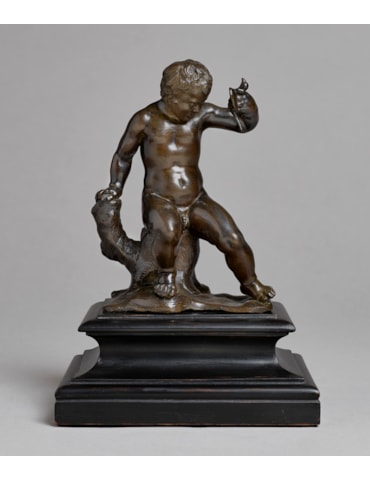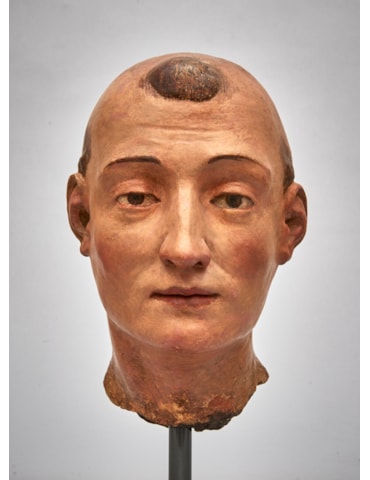Jean-Guillaume Moitte
Paris 1746 - Paris 1810
Paetus & Arria after the Ludovisi Gaul
Terracotta maquette
Height: 23.8 cm / 9 3/8 in
Height: 23.8 cm / 9 3/8 in
ENQUIRIES
+44 (0)20 7259 0707
Facture: The surface of this freely modelled terracotta group is in an excellent state. Only the man's raised right arm has been restored, and the fingertips of the woman’s left hand are lacking. This delicate terracotta sketch is a reinterpretation of the Ludovisi Gaul, one of the most popular sculpture groups of ancient Rome. The marble group was probably discovered during the construction of the Villa Ludovisi, just prior to 1623 when an inventory of the building was compiled.1
The antique marble depicts a clean-shaven man wearing a cape, plunging a sword into his neck with his right hand, while with his left he supports a deceased woman who has fallen onto her knees with her head to one side. In 1633 the group was described as “un certo mario ch’ammazza la figlia e se stesso” [a certain Mario who is killing his daughter and himself],2 referring to the story of the Roman patrician Sextus Marius. After attempting to protect his daughter from the advances of Emperor Tiberius, Marius was accused of incest but saved his family’s honour by killing his daughter and committing suicide. Among the many interpretations of the group are Pyramus & Thisbe, Paetus & Arria, Fulvius & his wife, a Gaul & his Wife, Macareus & Canace, and Menophilus & Drypetina. Since 1670 it has more generally been referred to as either Paetus & Arria or the Ludovisi Gaul.3 Paetus was a Roman senator who was ordered by Emperor Claudius to commit suicide in order to excuse his role in a rebellion. Incapable of killing himself, Paetus was admonished by his wife Arria, who grabbed the dagger out of his hand, stabbed herself and told her husband “it does not hurt”.4 The group depicts Paetus’ shock and dismay at his wife’s actions. The marble in Rome is now believed to be a Roman copy of a Greek bronze group at Pergamon erected to commemorate Attalus’ victory over the Galatians (Gauls who lived in Thrace, present-day Anatolia) in about 228 BC. Reductions and copies of the group became very popular in Europe in the seventeenth and eighteenth centuries. As a student of the sculptors Jean-Baptiste Pigalle (1714-1785) and Jean-Baptiste Lemoyne (1704 -1778), Moitte would have been familiar with the numerous fine reproductions of the Ludovisi Gaul in the French Royal Collections. They included a marble copy of circa 1684, made for Louis XIV by François Lespingola (1644-1705), who also made a slightly different version in bronze;5 a bronze reduction by Gianfrancesco Susini (1585 – 1658) given by André Le Nôtre to Louis XIV in 1693 and now in the Louvre;6 and another unattributed bronze, now lost.7 The French Academy in Rome also had a plaster cast of the Ludovisi Gaul from which other replicas were made.8 Moitte would have known both the plaster cast and the antique marble, as he won the Prix de Rome for sculpture in 1768 and was at the French Academy in Rome from October 1771 – May 1773.9
While in the Eternal City he made many drawings after the antique, and upon his return to Paris he was first known as a draughtsman; his talent for sculpting only becoming known in about 1783.10 He drew a scene of Paetus & Arria that was sold at the auction of the possessions of his wife, Madame Adélaïde Marie-Anne Castellas-Moitte, held after her death (Paris, 20-21 August 1807). Listed as lot 11, it was described as: “Arrie après s’être enfoncé un poignard dans le sein, le présent à Paetus son mari en lui disant: Tiens Paetus il ne m’a point fait de mal. Ce dessin à la plume est lavé à l’incre de Chine.”10 [Arria after plunging a dagger into her breast, showing herself to her husband Paetus and saying to him: See, Paetus, it does not hurt. This pen and ink drawing with [Chinese or India] ink wash].11 A second drawing of this subject ascribed to François-André Vincent (1746-1816) was a pen and sepia drawing made for the late doctor “M. Cochu”. Described in the same manner as lot 11, it was lot 32 and listed at 58 livres.12 These drawings are untraced, but demonstrate Moitte’s interest in the subject. Comparison of this very loosely sketched terracotta model to the many similar works recorded by Moitte endorses this attribution. They are all characterized by the same free modelling and many are made from a seemingly identical type of granular clay that is evident in their slightly rough surface, with a lightly modelled square base: see Moitte’s sketch for Jean-Jacques Roussseau, 1794, (h. 34 cm, Paris Musée Carnavalet)13. The freshness of Moitte’s modelling is otherwise rarely seen in French terracottas of this period; it infers a swift execution and sureness of form and technique while retaining a strong sense of the wet clay. At the same time he includes fine details such as the wet drapery worn by the woman, and definition of the figures’ hair and the man’s beard. The terracotta sketches of Mars, Diana, and Ceres, display wet drapery that folds between the legs of the women, while the muscles of the men’s arms are similarly roughly defined (heights 33, 33.5 and 32 cm respectively, all Paris, Musée de la Légion d’Honneur).14 This roughness combined with movement and a similar treatment of the head is also seen in the figure of Aeolus, from the Allegory of the Invention of the aerostatic balloon of the Montgolfier Brothers, (pen and ink wash, 37.5 x 26.5 cm, Paris, École des Beaux-Arts).15 In his revision of the Ludovisi Gaul, the artist has added a rough beard and interpreted the hair more loosely than in the antique, giving the group a stronger sense of motion. He created a tighter composition by placing the Gaul’s right arm closer to his body, and by moving the female Gaul closer to his left leg against his body. The vigorous pose of the striding male figure and the furrowed brow of his face seem to have been influenced by Bernini’s David and the figure of Pluto in the Rape of Proserpina, (now both Rome, Galleria Borghese). The Rape of Proserpina was commissioned by Cardinal Scipione Borghese in 1622 and given to Cardinal Ludovico Ludovisi the following year. It was displayed at the Villa Ludovisi until the early twentieth century, when it was purchased by the Italian state and sent to the Galleria Borghese. Moitte would have known of Bernini’s groups and the antique Ludovisi Gaul, and seems to have been inspired to combine classical and modern compositions in this dynamic small sketch.
1. For this and the following see F. Haskell & N. Penny, Taste and the Antique, The Lure of Classical Sculpture 1500-1900, London, 1981, pp. 282-284, no. 68, fig. 149, as Paetus & Arria, Rome, Museo Nazionale Romano (Museo delle Terme), marble, h. 2.11 m.
2. Haskell & Penny 1981, p. 282
3. Ibid., p.282
4. Ibid., p. 282.
5. Haskell & Penny 1981, p. 284 describe Lespingola’s marble copy at the entrance to the Tapis Vert at Versailles, for the bronze see Françoise de la Moureyre, in “Bronzes in the Age of Louis XIV,” in Cast in Bronze, French Sculpture from Renaissance to Revolution, eds. G. Bresc-Bautier, G. Scherf & J. Draper, exh. cat., Paris, Musée du Louvre, 22 October 2008- 19 January 2009; New York, The Metropolitan Museum of Art, 24 February – 24 May 2009; Los Angeles, The J. Paul Getty Museum, 30 June – 27 September 2009, p. 231, n.6, there described to be in the Assemblée Nationale, Paris.
6. Louvre, inv. no. OA 7338, h. 42 cm, the French Royal collection No. 198 engraved on the woman’s mantle see Les Bronzes de la Couronne, Paris, Musée du Louvre, 12 April – 12 July 1999, p. 137, no. 198.
7. Les Bronzes de la Couronne, Paris, Musée du Louvre, 12 April – 12 July 1999, p. 74, no. 2, h. 40.6 cm, perhaps acquired in 1662, sold 1803, Jourdan, lot no. 88.
8. Haskell & Penny 1981, p. 284
9. V. Atwater & P. Durey, "Moitte." Grove Art Online. Oxford Art Online. 30 Jun. 2010.
10. Ibid.
11. G. Gramaccini, Jean-Guillaume Moitte. Leben und Werk, Berlin, 1993, vol. 1, p. 300.
12. Ibid., vol. 1, p. 301.
13. Ibid., p. 285, fig. 293. See also Madonna and Child, attributed to Moitte, h. 41.5 cm, ca. 1784, London, Victoria and Albert Museum, in Ibid., p. 220, figs 164 &165.
14. Ibid. pp. 190-191, figs 92-93.
15. Ibid., p. 215 fig. 155, cat. no. 100.
The antique marble depicts a clean-shaven man wearing a cape, plunging a sword into his neck with his right hand, while with his left he supports a deceased woman who has fallen onto her knees with her head to one side. In 1633 the group was described as “un certo mario ch’ammazza la figlia e se stesso” [a certain Mario who is killing his daughter and himself],2 referring to the story of the Roman patrician Sextus Marius. After attempting to protect his daughter from the advances of Emperor Tiberius, Marius was accused of incest but saved his family’s honour by killing his daughter and committing suicide. Among the many interpretations of the group are Pyramus & Thisbe, Paetus & Arria, Fulvius & his wife, a Gaul & his Wife, Macareus & Canace, and Menophilus & Drypetina. Since 1670 it has more generally been referred to as either Paetus & Arria or the Ludovisi Gaul.3 Paetus was a Roman senator who was ordered by Emperor Claudius to commit suicide in order to excuse his role in a rebellion. Incapable of killing himself, Paetus was admonished by his wife Arria, who grabbed the dagger out of his hand, stabbed herself and told her husband “it does not hurt”.4 The group depicts Paetus’ shock and dismay at his wife’s actions. The marble in Rome is now believed to be a Roman copy of a Greek bronze group at Pergamon erected to commemorate Attalus’ victory over the Galatians (Gauls who lived in Thrace, present-day Anatolia) in about 228 BC. Reductions and copies of the group became very popular in Europe in the seventeenth and eighteenth centuries. As a student of the sculptors Jean-Baptiste Pigalle (1714-1785) and Jean-Baptiste Lemoyne (1704 -1778), Moitte would have been familiar with the numerous fine reproductions of the Ludovisi Gaul in the French Royal Collections. They included a marble copy of circa 1684, made for Louis XIV by François Lespingola (1644-1705), who also made a slightly different version in bronze;5 a bronze reduction by Gianfrancesco Susini (1585 – 1658) given by André Le Nôtre to Louis XIV in 1693 and now in the Louvre;6 and another unattributed bronze, now lost.7 The French Academy in Rome also had a plaster cast of the Ludovisi Gaul from which other replicas were made.8 Moitte would have known both the plaster cast and the antique marble, as he won the Prix de Rome for sculpture in 1768 and was at the French Academy in Rome from October 1771 – May 1773.9
While in the Eternal City he made many drawings after the antique, and upon his return to Paris he was first known as a draughtsman; his talent for sculpting only becoming known in about 1783.10 He drew a scene of Paetus & Arria that was sold at the auction of the possessions of his wife, Madame Adélaïde Marie-Anne Castellas-Moitte, held after her death (Paris, 20-21 August 1807). Listed as lot 11, it was described as: “Arrie après s’être enfoncé un poignard dans le sein, le présent à Paetus son mari en lui disant: Tiens Paetus il ne m’a point fait de mal. Ce dessin à la plume est lavé à l’incre de Chine.”10 [Arria after plunging a dagger into her breast, showing herself to her husband Paetus and saying to him: See, Paetus, it does not hurt. This pen and ink drawing with [Chinese or India] ink wash].11 A second drawing of this subject ascribed to François-André Vincent (1746-1816) was a pen and sepia drawing made for the late doctor “M. Cochu”. Described in the same manner as lot 11, it was lot 32 and listed at 58 livres.12 These drawings are untraced, but demonstrate Moitte’s interest in the subject. Comparison of this very loosely sketched terracotta model to the many similar works recorded by Moitte endorses this attribution. They are all characterized by the same free modelling and many are made from a seemingly identical type of granular clay that is evident in their slightly rough surface, with a lightly modelled square base: see Moitte’s sketch for Jean-Jacques Roussseau, 1794, (h. 34 cm, Paris Musée Carnavalet)13. The freshness of Moitte’s modelling is otherwise rarely seen in French terracottas of this period; it infers a swift execution and sureness of form and technique while retaining a strong sense of the wet clay. At the same time he includes fine details such as the wet drapery worn by the woman, and definition of the figures’ hair and the man’s beard. The terracotta sketches of Mars, Diana, and Ceres, display wet drapery that folds between the legs of the women, while the muscles of the men’s arms are similarly roughly defined (heights 33, 33.5 and 32 cm respectively, all Paris, Musée de la Légion d’Honneur).14 This roughness combined with movement and a similar treatment of the head is also seen in the figure of Aeolus, from the Allegory of the Invention of the aerostatic balloon of the Montgolfier Brothers, (pen and ink wash, 37.5 x 26.5 cm, Paris, École des Beaux-Arts).15 In his revision of the Ludovisi Gaul, the artist has added a rough beard and interpreted the hair more loosely than in the antique, giving the group a stronger sense of motion. He created a tighter composition by placing the Gaul’s right arm closer to his body, and by moving the female Gaul closer to his left leg against his body. The vigorous pose of the striding male figure and the furrowed brow of his face seem to have been influenced by Bernini’s David and the figure of Pluto in the Rape of Proserpina, (now both Rome, Galleria Borghese). The Rape of Proserpina was commissioned by Cardinal Scipione Borghese in 1622 and given to Cardinal Ludovico Ludovisi the following year. It was displayed at the Villa Ludovisi until the early twentieth century, when it was purchased by the Italian state and sent to the Galleria Borghese. Moitte would have known of Bernini’s groups and the antique Ludovisi Gaul, and seems to have been inspired to combine classical and modern compositions in this dynamic small sketch.
1. For this and the following see F. Haskell & N. Penny, Taste and the Antique, The Lure of Classical Sculpture 1500-1900, London, 1981, pp. 282-284, no. 68, fig. 149, as Paetus & Arria, Rome, Museo Nazionale Romano (Museo delle Terme), marble, h. 2.11 m.
2. Haskell & Penny 1981, p. 282
3. Ibid., p.282
4. Ibid., p. 282.
5. Haskell & Penny 1981, p. 284 describe Lespingola’s marble copy at the entrance to the Tapis Vert at Versailles, for the bronze see Françoise de la Moureyre, in “Bronzes in the Age of Louis XIV,” in Cast in Bronze, French Sculpture from Renaissance to Revolution, eds. G. Bresc-Bautier, G. Scherf & J. Draper, exh. cat., Paris, Musée du Louvre, 22 October 2008- 19 January 2009; New York, The Metropolitan Museum of Art, 24 February – 24 May 2009; Los Angeles, The J. Paul Getty Museum, 30 June – 27 September 2009, p. 231, n.6, there described to be in the Assemblée Nationale, Paris.
6. Louvre, inv. no. OA 7338, h. 42 cm, the French Royal collection No. 198 engraved on the woman’s mantle see Les Bronzes de la Couronne, Paris, Musée du Louvre, 12 April – 12 July 1999, p. 137, no. 198.
7. Les Bronzes de la Couronne, Paris, Musée du Louvre, 12 April – 12 July 1999, p. 74, no. 2, h. 40.6 cm, perhaps acquired in 1662, sold 1803, Jourdan, lot no. 88.
8. Haskell & Penny 1981, p. 284
9. V. Atwater & P. Durey, "Moitte." Grove Art Online. Oxford Art Online. 30 Jun. 2010
10. Ibid.
11. G. Gramaccini, Jean-Guillaume Moitte. Leben und Werk, Berlin, 1993, vol. 1, p. 300.
12. Ibid., vol. 1, p. 301.
13. Ibid., p. 285, fig. 293. See also Madonna and Child, attributed to Moitte, h. 41.5 cm, ca. 1784, London, Victoria and Albert Museum, in Ibid., p. 220, figs 164 &165.
14. Ibid. pp. 190-191, figs 92-93.
15. Ibid., p. 215 fig. 155, cat. no. 100.





